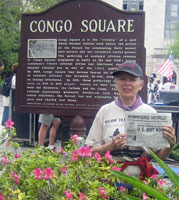‘Walking to New Orleans’
Lessons from a historic march
Published Apr 1, 2006 8:41 PM
From a talk given by Minnie Bruce Pratt at a Workers World Party meeting
on March 24 in New York.
|
Minnie Bruce Pratt in Congo
Square, New Orleans.
WW photo
|
“Walking to New Orleans”
[March 13 to 19] was significant because the two groups that organized the march
have historically been pitted against each other in the U.S. South—the
mostly white working-class veterans and relatives, represented by Veterans for
Peace and Military Families Speak Out, and the mostly African-American community
leaders responding to the government-induced Katrina catastrophe, represented by
Saving Our Selves in Mobile and the People’s Hurricane Relief Fund in New
Orleans.
We heard from Katrina survivors—a Peruvian family being
aided by the Mississippi Immigrant Rights Alliance; we marched by tables of
Mexican and Guate malan male workers at lunch who waved to us; we heard how
Vietnamese fishing people in Mobile were put out of work by the hurricane; in
New Orleans, we—and especially the Vietnam vets!—were given a place
to sleep by the Vietnamese community. And we heard how Jamaican and Haitian
workers at the gigantic casinos along the Biloxi gulf shore were abandoned by
their employers as the fury of the storm struck.
There were stretches of
road where cars and trucks blared their horns in support of the march so
incessantly that we couldn’t hear each other chant. This happened in a
region where that symbol of racism, the Confederate flag, has been replaced for
the most part by the U.S. flag, which overt racists can hide behind in voicing
their white supremacist views.
The ruling class—from slave owners in
the 18th century through steel mill owners in the 20th century—have tried
to split the working class by instilling and fomenting racism within the white
working class against African Americans and also immigrants of color in the U.S.
South.
The South is being globalized, perhaps faster than any other part
of the U.S. In the 1990s the South attracted more than half the foreign
investment. One out of every eight workers in the South now gets her/his
paycheck from a non-U.S. employer.
Most of the well-paying factory jobs
are still going to white workers, and the bosses are still fighting to keep the
region non-union. The U.S. South is the most militarized and the most dependent
on military-related civilian jobs.
The following statistics include jobs,
both military and civilian, in this very poor region:
* 42 percent of
U.S. troops came from the South in 2002 (the region has just one-third of the
country’s population).
* The South accounts for seven of the 16
states where military recruiters enlisted the greatest share of 17- to
24-year-olds (and those seven states include Alabama and Louisiana).
* 51
percent of active-duty U.S. military personnel in the continental U.S. are
stationed in the South.
* 38 percent of U.S. troops killed in Iraq and 47
percent killed in Afghanistan had been based in the South.
* 43 percent of
prime military contracts from the Department of Defense went to the South in
2002, and 32 percent of those contracts in most of 2005. (Institute for Southern
Studies)
In the 1980s, white supremacist David Duke tried to resuscitate
the Ku Klux Klan in Slidell, La., as a well-educated, articulate, 20th-century
hate group. Duke ran as a Republican for the Louisiana Senate in 1990. But
before that, in 1981, Don Black, his right-hand man, put together in Slidell a
group of nine other neo-Nazis and Klansmen plotting to invade the Caribbean
island of Dominica, overthrow its government, and turn it into a “white
state.”
We were greeted warmly in Slidell by young white male
workers, Latino workers eating lunch, a young African-American male truck
driver, older white couples and young white women in their cars. This warm
response suggests that the double crisis generated by the ruling class through
the war on Iraq and the re-doubled oppression of the working-class by way of the
Katrina catastrophe has opened a possibility for working-class unity across
national lines.
At the final rally in historic Congo Square in New
Orleans, a speaker-phone broadcast included Fernando Suarez, whose son died in
Iraq and who has became an outspoken critic of the war, especially the targeting
of Latin@ and other youth of color by military recruiters.
Jeff, an Iraq
War vet, a young white man in his 20s, a member of a Louisiana Army Reserves
unit deployed to Iraq during the Katrina catastrophe, said, “When the
disaster hit, I was serving a 13-month sentence in Iraq. There we drove trucks,
cleaned up debris, established mortuaries for deaths caused because the U.S.
made preemptive war against a sovereign country, against the U.N.
Charter.” Finally, he spoke of having seen an Iraqi woman lying dead, and
how that was the turning point for him. He cried out, “I thought to
myself, what if that were my mother lying there? My sister? What would I do? I
would fight! I’d be a freedom fighter for my country! Here in the U.S. the
Iraqis who fight are called terrorists. I call them freedom fighters.”
Articles copyright 1995-2012 Workers World.
Verbatim copying and distribution of this entire article is permitted in any medium without royalty provided this notice is preserved.
Workers World, 55 W. 17 St., NY, NY 10011
Email:
[email protected]
Subscribe
[email protected]
Support independent news
DONATE


